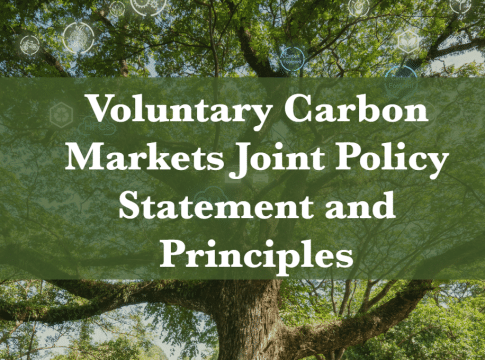US Government Releases New Voluntary Carbon Credit Market Policy Guidelines
The Biden administration announced the release of the “Voluntary Carbon Markets Joint Policy Statement and Principles”, aiming to enhance and advance the market for carbon credits by establishing the US government’s guidelines to ensuring the high integrity of voluntary carbon markets (VCMs).
This policy statement arrives as demand for carbon offset projects and related credits will surge. It’s primarily due to companies pursuing net zero goals and using offsets to complement their emissions reduction efforts or to balance unavoidable emissions. Notably, the Science Based Targets initiative (SBTi) recently indicated that carbon credits may be allowed in net zero targets to address Scope 3 emissions.
Despite the growth, the market faces significant integrity challenges. Participants struggle to differentiate between high and low-quality projects due to insufficient or inconsistent data on project effectiveness.
Announcing the new carbon credits guidelines, US Treasury Secretary Janet Yellen stated:
“Voluntary carbon markets can help unlock the power of private markets to reduce emissions, but that can only happen if we address significant existing challenges. The principles released today are an important step toward building high-integrity voluntary carbon markets. This is part of the Biden administration’s ambitious efforts to tackle the climate crisis and accelerate a clean energy transition that benefits all Americans.”
Here Are the Key Points of the Policy Guidelines:
Certified Carbon Credits
Carbon credits and the activities that generate them must meet credible atmospheric integrity standards, representing real decarbonization. They should be certified to robust standards for design and MMRV (Measurement, Monitoring, Reporting, and Verification).
Core principles include additionality (activities wouldn’t occur without the crediting mechanism), uniqueness (one credit corresponds to one tonne of CO2 reduced or removed without double-issuance), and real, quantifiable emission reductions. Activities must prevent leakage and be validated and verified by an independent third party.
Permanence is essential, ensuring emissions stay out of the atmosphere for a specified period. More remarkably, robust baselines should avoid over-crediting and reflect advancements in climate policy and technology.
Climate and Environmental Justice
Credit-generating activities should avoid environmental and social harm, supporting co-benefits and transparent, inclusive benefits-sharing. Understanding climate and environmental justice impacts is crucial, and developers should avoid negative externalities for local communities.
Safeguards must prevent adverse impacts on people and the environment, including land use, tenure rights, food security, and biodiversity. Continuous monitoring and mitigation of adverse impacts are necessary, with efforts to enhance positive impacts where possible.
Verified co-benefits, such as sustainable economic development and increased biodiversity, are encouraged. Projects should be designed and implemented in consultation with relevant stakeholders, respecting Free, Prior, and Informed Consent where applicable.
Emissions Reductions Within Value Chains
Corporate buyers of credits should prioritize measurable emissions reductions within their own value chains. The use of credits involves purchasing and canceling or retiring them, and making public claims based on their climate impact. To achieve long-term climate goals, businesses must transform their models across economies.
Credit users should use VCMs to complement measurable within-value-chain emissions reductions as part of their net zero strategies. This includes taking inventory of Scope 1, 2, and 3 emissions, regularly reporting them, setting near-term emissions reduction targets, and adopting transition plans. Where feasible, companies should collaborate with their stakeholders to achieve these goals.
Disclosure of Purchased and Retired Credits
Credit users should disclose purchased, canceled, or retired credits annually, providing details to assess their integrity and environmental and social impacts. This disclosure may exceed legal requirements and should be in a standardized, easily accessible format for comparability.
Users should consider reporting to aggregating resources that disseminate this information publicly, ensuring stakeholders can evaluate the credibility and impacts of the credits.
RELATED: SEC Finalizes New Climate Disclosure Rule: Here’s What’s New
Accurate Public Claims
Public claims by credit users must reflect the true climate impact of retired credits, using only high-integrity carbon credits. Claims should support ongoing incentives for within-value-chain emissions reductions and align with developing frameworks.
Credits should meet high integrity standards, avoiding claims based on reversed or failed credits unless remediated. Corporate climate strategies should prioritize within-value-chain reductions, using credible credits to complement efforts.
Improving Market Integrity
Market participants should enhance market integrity by creating incentives for high-integrity carbon credits, improving transparency, and ensuring fair treatment of suppliers. Measures include preventing fraud, promoting global standards interoperability, and supporting equitable market participation.
Enhancing market functionality involves collaboration among private, public, and civil sectors, focusing on robust data, fair revenue distribution, and clear accounting practices to support the health of VCMs.
Facilitating Efficient Market Participation
Policymakers and market participants should lower transaction costs and support credit providers, especially those in developing countries. Addressing barriers for suppliers can enhance VCMs’ ability to produce high-integrity credits.
Efforts should include using robust models to reduce MMRV costs and providing market certainty for long-term decarbonization investments. Supporting credible credit providers is crucial for advancing decarbonization and generating economic opportunities as part of the climate strategy.
The new US’ voluntary carbon credit guidelines was co-signed by senior administration officials, including Treasury Secretary Janet Yellen, Agriculture Secretary Tom Vilsack, Energy Secretary Jennifer Granholm, Senior Advisor for International Climate Policy John Podesta, National Economic Advisor Lael Brainard, and National Climate Advisor Ali Zaidi.
READ MORE: CFTC’s New Proposal Guides Voluntary Carbon Credit Trading
The post US Government Releases New Voluntary Carbon Credit Market Policy Guidelines appeared first on Carbon Credits.



